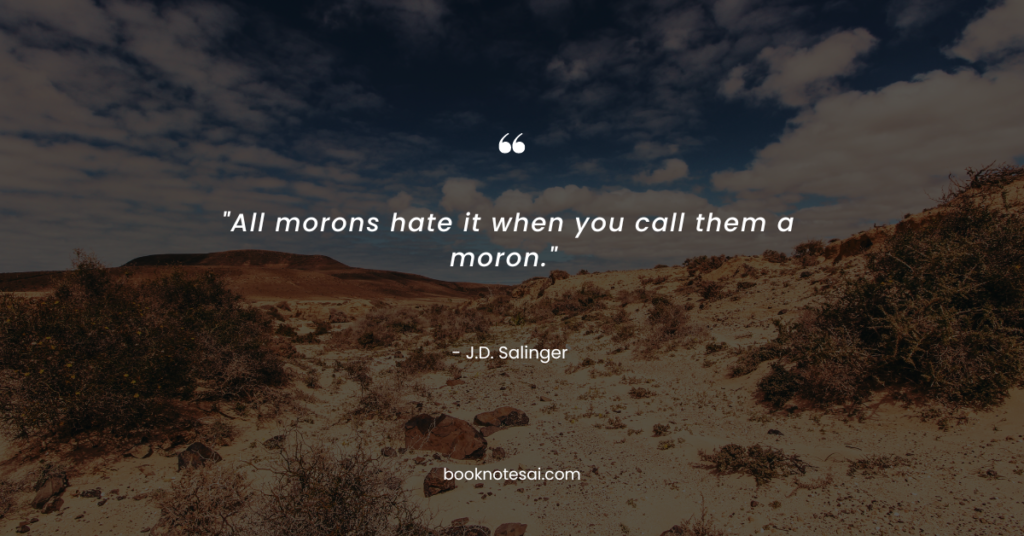Listen To This Post
The Catcher in the Rye Summary: A Classic Coming-of-Age Story.

This is a book summary for The Catcher in the Rye by J.D. Salinger. The essential information is structured to be straightforward, useful, and valuable, all while helping you save plenty of time.
Introduction: Why this book?
- Captivating Narrative: The Catcher in the Rye is a timeless exploration of teenage angst and rebellion, resonating with readers across generations. Its vivid portrayal of adolescent struggles and search for identity makes it a must-read.
- Universal Themes: Through the protagonist Holden Caulfield, readers delve into themes of alienation, innocence, and the loss of childhood, offering profound insights into the human experience.
The Catcher in the Rye Summary:
- Holden Caulfield, a disillusioned teenager, narrates his experiences after being expelled from prep school. He embarks on a journey through New York City, grappling with the phoniness of adult society and longing for authenticity.
- Throughout the novel, Holden’s encounters with various characters, including his sister Phoebe and former teacher Mr. Antolini, highlight his internal turmoil and quest for connection.
- As Holden navigates the complexities of adolescence, readers witness his struggle to preserve innocence in a world filled with hypocrisy and disillusionment.
- Ultimately, Holden’s desire to protect the innocence of children, symbolized by the image of the “catcher in the rye,” underscores the novel’s themes of innocence and authenticity.
- Salinger’s masterful storytelling and poignant exploration of youth make The Catcher in the Rye a timeless classic that continues to captivate readers worldwide.
💡 5 Big Ideas
- Preserving Innocence: Salinger emphasizes the importance of preserving innocence in a world tainted by phoniness and corruption.
Holden’s desire to protect children from the harsh realities of adulthood reflects the longing for purity and authenticity. - Alienation and Isolation: Through Holden’s alienation from society, readers confront the universal experience of feeling disconnected and misunderstood. His sense of isolation serves as a poignant reminder of the human condition.
- The Search for Identity: Holden’s quest for identity and belonging resonates with readers navigating their own journey of self-discovery.
His existential ponderings and rebellion against societal norms reflect the struggle to find one’s place in the world. - Loss of Innocence: The novel explores the inevitable loss of innocence as individuals confront the complexities of adulthood.
Holden’s reluctance to embrace maturity underscores the poignant transition from childhood to adolescence. - The Power of Authenticity: Salinger celebrates authenticity and genuine human connections amidst a world of superficiality.
Holden’s yearning for sincerity serves as a compelling reminder of the importance of staying true to oneself.
In summary, The Catcher in the Rye invites readers to reflect on the complexities of youth, the loss of innocence, and the search for authenticity in a world filled with phoniness.
Powerful Quotes
- “All morons hate it when you call them a moron.”
This quote highlights Holden’s disdain for superficiality and his longing for genuine connections. - “I’m quite illiterate, but I read a lot.”
Holden’s admission of illiteracy juxtaposed with his love for reading underscores the complexity of his character. - “People always clap for the wrong reasons.”
This quote reveals Holden’s perception of societal hypocrisy and the superficiality of human interactions. - “Don’t ever tell anybody anything. If you do, you start missing everybody.”
Holden’s reluctance to open up reflects his fear of vulnerability and the pain of emotional attachment. - “I’m the most terrific liar you ever saw in your life.”
Holden’s confession of his deceitful nature highlights his struggle with authenticity and self-identity. - “Certain things they should stay the way they are. You ought to be able to stick them in one of those big glass cases and just leave them alone.”
Holden’s desire to preserve innocence and authenticity encapsulates his longing for stability in a changing world. - “I can be quite sarcastic when I’m in the mood.”
This quote reflects Holden’s defensive demeanor and his coping mechanism for dealing with societal pressures. - “People never believe you.”
Holden’s frustration with societal skepticism underscores his struggle to communicate his innermost thoughts and feelings. - “It’s funny. All you have to do is say something nobody understands and they’ll do practically anything you want them to.”
Holden’s manipulation of others highlights his disillusionment with the authenticity of human relationships. - “Among other things, you’ll find that you’re not the first person who was ever confused and frightened and even sickened by human behavior.”
This quote offers solace to readers grappling with their own existential dilemmas, reminding them of the universality of human experiences.
One Reason To Read This Book:
Immerse yourself in Holden Caulfield’s poignant journey of self-discovery and rebellion against societal norms, offering profound insights into the human condition.
Who should I recommend The Catcher in the Rye Summary to?
This summary is perfect for teenagers and young adults exploring themes of identity, rebellion, and authenticity.
It also appeals to readers interested in classic literature and psychological introspection.
Recommendations:
- “Franny and Zooey” by J.D. Salinger: Delve deeper into Salinger’s exploration of the human psyche and existential themes.
- “The Bell Jar” by Sylvia Plath: Explore another coming-of-age novel that delves into themes of mental illness and societal pressures.
This summary serves as a complimentary guide to the reviewed title The Catcher in the Rye, offering key insights. For a deeper understanding, we encourage you to explore the full book.


